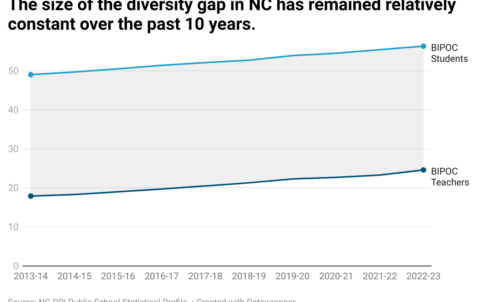Looking at the teacher/student diversity gap in North Carolina

Teacher diversity has been found to be linked to improved educational outcomes for all students, with more targeted gains for students of color. Specifically, having a same-race teacher is associated with improved test scores, grades, and attendance, as well as a higher probability of taking advanced math courses, being selected for gifted and talented programs, graduating high school, and enrolling in college.
Despite demographic shifts with the state population overall, data suggest there’s still a mismatch between the racial/ethnic identity of teachers and the student population. Approximately 49% of students and 18% of teachers identified as being Black, Indigenous, or Other person of color (BIPOC) in 2013-14, whereas 56% of students and 25% of teachers identified as being a BIPOC in 2022-23; although populations of color increased during this 10-year period, the ratio of BIPOC teachers to BIPOC students did not substantially shift (Figure 1).
The difference between the racial composition of the teacher workforce and the students they serve is known as a diversity gap. In NC, it is important to note that the gap was largest in 2021-22 (32.1% difference) and the smallest in 2013-14 (31.1% difference) – meaning there was only a 1% point reduction from the largest gap size.
We’ve calculated BIPOC student/teacher racial composition for a 10-year period (2013-14 to 2022-23) for the five largest school districts in the state – Wake, Charlotte-Mecklenburg, Guilford, Forsyth, and Cumberland (Figure 2). We found that Charlotte-Mecklenburg had the highest percentages of students of color for each year analyzed, whereas Wake had the lowest. Guilford and Cumberland had the highest percentages of teachers of color, while Wake had the lowest.
Additionally, we calculated the sizes of the diversity gap for the five school districts (Figure 3). Charlotte-Mecklenburg had the largest gaps between teacher and student racial composition, followed by Forsyth, then Cumberland, then Wake, and finally, Guilford.
It is interesting to note that even though Guilford had the smallest gap to begin with, the county's gap decreased the most, resulting in an overall decrease of 5.2% from 2013-14 to 2022-23.
Charlotte-Mecklenburg, Wake, and Cumberland had the second, third, and fourth largest decreases in the size of the gap, with 2.4%, 1.3%, and 0.7 reductions respectively, between 2013-14 to 2022-23. Forsyth, however, experienced a net increase in the size of their diversity gap of-2% for the same period.
Nationally and statewide, there are initiatives to increase equitable teacher representation. In 2019, during a summit to discuss this issue, Governor Cooper announced the creation of the Developing a Representative and Inclusive Vision for Education (DRIVE) task force.
The DRIVE task force released an action plan in June 2022, which outlined specific strategies to recruit, support, and retain a diverse teacher workforce that more equitably reflects the student population in the state. All goals specified in the plan require extensive investment from state, district, and local leadership.
Recommendations in the report center on expanding and strengthening the teacher preparation pipeline in North Carolina. Specifically, the Committee recommends expanding residency and alternative pathway programs to attract more students of color into teaching, subsidizing licensing and National Board certification exams with priority given to students of color, developing streamlined paths for students from community colleges to teacher prep programs through articulation agreements, and expanding teacher prep programs at NC’s Historically Minority-Serving Institutions (HMSIs).
Though many of these recommendations address the entirety of the state, our analysis shows that the racial composition of the public-school teacher population differs greatly even among NC’s most populous counties. There’s no doubt that demographic and economic forces and shifts are driving the trends in these data; however, as education leaders and stakeholders prepare to recruit more non-white teachers to better serve an increasingly diverse K-12 student population, there may be approaches and practices at a county-level that could help to inform policy for other districts and the state. Further analysis of the approaches used by these districts could provide evidence-based insight into additional effective ways to close the diversity gap statewide.
Need help understanding population change and its impacts on your community or business? Carolina Demography offers demographic research tailored to your needs.
Contact us today for a free initial consultation.
Contact UsCategories: Education

The Center for Women’s Health Research (CWHR) at the University of North Carolina School of Medicine released the 12th edition of our North Carolina Women’s Health Report Card on May 9, 2022. This document is a progress report on the…

Dr. Krista Perreira is a health economist who studies disparities in health, education, and economic well-being. In collaboration with the Urban Institute, she recently co-led a study funded by the Kate B. Reynolds Foundation to study barriers to access to…

Our material helped the NC Local News Lab Fund better understand and then prioritize their funding to better serve existing and future grant recipients in North Carolina. The North Carolina Local News Lab Fund was established in 2017 to strengthen…
Your support is critical to our mission of measuring, understanding, and predicting population change and its impact. Donate to Carolina Demography today.